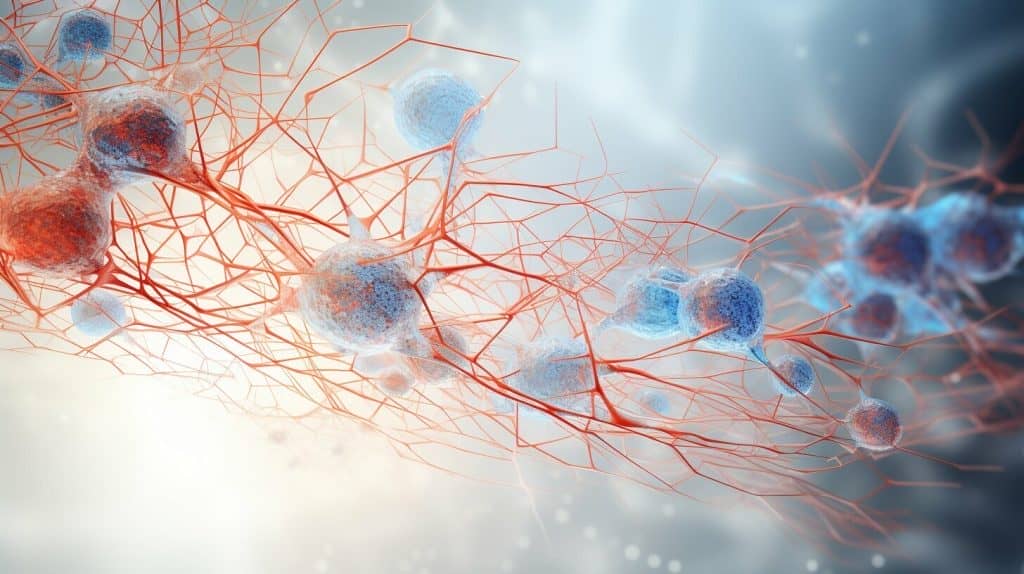Lyme Disease is a bacterial infection that is transmitted through tick bites. It can cause a wide range of symptoms, including fever, fatigue, headache, and joint pain. Stroke, on the other hand, occurs when a blood vessel in the brain is blocked or burst, resulting in damage to brain tissue.
There has been much debate among medical professionals about the relationship between Lyme Disease and stroke. While some have suggested a link between the two conditions, others have dismissed such claims as unfounded. In this article, we will delve into the topic and explore whether Lyme Disease can cause stroke and examine the connection between the two conditions.
Understanding Lyme Disease and Stroke
Lyme Disease is a bacterial infection transmitted to humans through the bite of infected black-legged ticks. The disease can impact various parts of the body, including the heart, joints, and nervous system. It can cause a wide range of symptoms, such as fever, headache, fatigue, joint pain, and neurological issues.
Stroke, on the other hand, occurs when blood flow to part of the brain is interrupted or reduced, resulting in brain cell damage. Stroke can happen due to various reasons, such as high blood pressure, blood clots, or bleeding in the brain.
Lyme Disease and Cerebrovascular Disease
While Lyme Disease is not a direct cause of cerebrovascular disease (CVD), it has been associated with an increased risk of stroke. CVD refers to various conditions that affect blood vessels supplying the brain, including stroke.
A study published in the Journal of Stroke and Cerebrovascular Diseases found that patients with Lyme Disease had a higher risk of developing CVD than those without the disease. The study suggested that the inflammation and immune responses triggered by Lyme Disease may contribute to an increased risk of CVD.
Stroke as a Complication of Lyme Disease
Several case reports suggest that stroke can occur as a complication of Lyme Disease, particularly in patients who have not received adequate treatment. A case study published in the journal Neurology described a patient with Lyme Disease who had multiple ischemic strokes. The strokes were thought to be due to inflammation caused by the disease.
It is important to note that stroke is a rare complication of Lyme Disease. Most patients with Lyme Disease do not develop stroke.
Lyme Disease and Ischemic Stroke
Ischemic stroke is the most common type of stroke and occurs when a blood vessel supplying the brain is blocked by a blood clot. Lyme Disease has been linked to an increased risk of ischemic stroke, although the exact mechanism is not yet fully understood.
A study published in the journal Frontiers in Neurology found that patients with Lyme Disease had a higher prevalence of ischemic stroke than those without the disease. The study suggested that the inflammation and vascular damage caused by Lyme Disease may contribute to an increased risk of ischemic stroke.
The Neurological Complications of Lyme Disease
Lyme Disease is caused by the bacterium Borrelia burgdorferi, which is transmitted to humans through the bite of infected black-legged ticks. This disease primarily affects the skin, joints, heart, and nervous system. When left untreated or undertreated, it can lead to a range of neurological complications, including nerve inflammation, numbness, tingling, and shooting pain.
Lyme Disease can also cause neuroborreliosis, which is an infection of the brain and spinal cord. This condition is characterized by severe headaches, neck stiffness, facial palsy, memory loss, and difficulty thinking clearly. In some cases, neuroborreliosis can lead to life-threatening complications, such as meningitis and encephalitis.
| Neurological Complications of Lyme Disease | Description |
|---|---|
| Nerve inflammation | Swelling and irritation of the nerves, which can cause pain, weakness, and numbness. |
| Facial palsy | Weakness or paralysis of the muscles on one side of the face, which can cause drooping, eye problems, and difficulty speaking or eating. |
| Meningitis | Inflammation of the protective membranes that cover the brain and spinal cord, which can cause headache, fever, nausea, vomiting, and sensitivity to light. |
| Encephalitis | Inflammation of the brain tissue, which can cause fever, headache, confusion, seizures, and memory loss. |
Some individuals with Lyme Disease may also experience co-infections with other tick-borne illnesses, such as babesiosis and anaplasmosis. These co-infections can further complicate neurological symptoms and increase the risk of stroke.
Relationship Between Lyme Disease and Stroke
While the exact mechanism underlying the link between Lyme Disease and stroke is not fully understood, several theories have been proposed. One theory suggests that the bacterium responsible for Lyme Disease can trigger an inflammatory response in the blood vessels, leading to the formation of blood clots. These clots can block blood flow to the brain and cause a stroke. Another theory speculates that Lyme Disease may increase the risk of stroke indirectly by contributing to heart problems, such as atrial fibrillation and heart valve disease.
Research on the Link Between Lyme Disease and Stroke
Research on the link between Lyme Disease and stroke is still in its infancy. However, there have been some studies that suggest a correlation between the two conditions.
| Study | Findings |
|---|---|
| Case-control study by Marten et al. (2018) | Reported an association between Lyme Disease and ischemic stroke |
| Cohort study by Marquez et al. (2014) | Found a higher incidence of cerebrovascular disease in patients with Lyme Disease |
| Retrospective study by Kowarik et al. (2017) | Identified an increased risk of stroke in patients with neuroborreliosis |
While these studies suggest a connection between Lyme Disease and stroke, further research is needed to establish a causal relationship.
Research Gaps:
- Effect of Lyme Disease treatment on reducing stroke risk
- Long-term follow-up studies to assess stroke risk in patients with a history of Lyme Disease
- Impact of coinfection with other tick-borne illnesses on stroke risk in Lyme Disease patients
Given the limitations of current research, it is essential to approach the link between Lyme Disease and stroke with caution. Patients with Lyme Disease should monitor their symptoms carefully and seek medical attention promptly if they experience any signs of stroke.
Symptoms of Lyme Disease and Stroke
Both Lyme disease and stroke share some similar symptoms, which can make it difficult to distinguish between the two conditions. However, there are a few key differences to look out for.
Lyme Disease Symptoms
Lyme disease symptoms typically start with a rash that’s often described as a “bull’s-eye.” Other early symptoms can include fever, fatigue, headaches, and muscle aches. As the disease progresses, symptoms may include joint pain, swollen lymph nodes, and neurological problems like numbness and tingling in the hands or feet.
It’s important to note that not everyone with Lyme disease will experience all of these symptoms, and some individuals may not experience any symptoms at all.
Stroke Symptoms
Stroke symptoms can vary depending on the type of stroke, but common symptoms can include sudden weakness or numbness in the face, arm, or leg (especially on one side of the body), difficulty speaking or understanding speech, sudden trouble seeing in one or both eyes, sudden dizziness, loss of balance, or coordination, and a severe headache.
If you or someone you know is experiencing any of these symptoms, it’s crucial to seek medical attention immediately. Strokes require prompt treatment to minimize damage to the brain and prevent further complications.
Differentiating Between the Two
As previously mentioned, some of the symptoms of Lyme disease and stroke can overlap, which can make it challenging to distinguish between the two. However, there are a few key differences to look out for, such as the sudden onset of stroke symptoms versus the gradual onset of Lyme disease symptoms.
It’s also essential to consider any potential risk factors for either condition. For example, Lyme disease is often contracted through tick bites, while stroke risk factors can include high blood pressure, smoking, and a sedentary lifestyle.
If you’re experiencing any symptoms or are unsure about your risk for either condition, it’s always best to consult with a medical professional for guidance and diagnosis.
Preventative Measures for Lyme Disease and Stroke
Preventing Lyme Disease and stroke involves taking proactive steps to reduce risk factors. Here are some practical tips:
- Wear protective clothing when spending time outdoors in grassy or wooded areas.
- Perform daily tick checks, especially after spending time outside.
- Use insect repellent containing DEET on skin and clothing.
- Control tick habitats by keeping grass short and removing leaf litter.
- Use rodent control to reduce the presence of ticks in the environment.
- Stay up-to-date with vaccinations and immunizations for other diseases that may increase stroke risk.
If you have been diagnosed with Lyme Disease or have had a stroke, it is crucial to work closely with your healthcare provider to manage these conditions. Here are some additional preventative measures:
- Take prescribed antibiotics for Lyme Disease as directed by your healthcare provider.
- Manage high blood pressure, diabetes, and cholesterol levels to reduce the risk of stroke.
- Quit smoking and limit alcohol consumption.
- Exercise regularly and maintain a healthy diet to promote overall cardiovascular health.
Medical Treatments for Lyme Disease and Stroke
Early diagnosis and appropriate treatment are critical for managing both Lyme Disease and stroke. Following a thorough evaluation, your healthcare provider may recommend the following medical treatments:
| Treatment | Description |
|---|---|
| Antibiotics | If your Lyme Disease is caught early, antibiotics can be used to effectively treat the infection. The type, dosage, and duration of antibiotics depend on the stage of your disease and the symptoms you are experiencing. |
| Anticoagulants | If you are diagnosed with stroke, anticoagulants (blood thinners) may be prescribed to prevent blood clots from forming and reduce the risk of further strokes. |
| Thrombolytics | In some cases, thrombolytic medications may be used to dissolve blood clots that have caused a stroke. These medications are time-sensitive, meaning they must be administered within a few hours of symptom onset. |
| Anti-inflammatory drugs | Anti-inflammatory medications such as corticosteroids may be used to reduce inflammation in the brain and spinal cord caused by Lyme Disease. However, the use of these drugs is controversial and requires careful consideration by your healthcare provider. |
It is important to note that treatment options may vary depending on the severity of your condition and other individual factors. Always consult with your healthcare provider before starting any new treatments or medications.
Managing Lyme Disease and Stroke
Living with Lyme Disease and stroke can be challenging, but it’s possible to manage both conditions with proper care and support. Here are some tips for managing Lyme Disease and stroke simultaneously:
Maintain a Healthy Lifestyle
Following a healthy lifestyle can help manage both Lyme Disease and stroke. Eating a well-balanced diet, getting regular exercise, and avoiding smoking can improve overall health and reduce the risk of complications.
Seek Physical and Occupational Therapy
Physical and occupational therapy can help individuals with Lyme Disease and stroke improve their strength, balance, and coordination. Therapy can also help individuals learn new skills and ways to manage daily tasks.
Get Adequate Rest
Getting enough rest is crucial for managing both Lyme Disease and stroke. It’s important to prioritize sleep and avoid overexertion, which can worsen symptoms and increase the risk of complications.
Join a Support Group
Joining a support group can provide valuable emotional and social support for individuals with Lyme Disease and stroke. Support groups can offer a safe space to share experiences, learn from others, and connect with others who are going through similar experiences.
Work with Healthcare Providers
Working closely with healthcare providers is essential for managing both Lyme Disease and stroke. It’s important to follow recommended treatment plans, attend regular appointments, and communicate any changes in symptoms or health status to healthcare providers.
Make Necessary Adjustments
Living with Lyme Disease and stroke may require making necessary adjustments to daily routines and activities. It’s important to identify areas of difficulty and find ways to make adjustments or accommodations, such as using assistive devices or modifying the home environment, to improve quality of life.
Case Studies: Lyme Disease and Stroke
Real-life experiences have shed light on the relationship between Lyme Disease and stroke. In this section, we will discuss two case studies that highlight the potential dangers of Lyme Disease.
Case Study 1
| Age | Gender | Symptoms | Diagnosis | Treatment | Outcome |
|---|---|---|---|---|---|
| 45 | Female | Fatigue, joint pain, fever, headache, muscle weakness, difficulty speaking | Lyme Disease, Ischemic Stroke | Antibiotics, physical therapy, speech therapy | Partial recovery, ongoing symptoms |
One patient, a 45-year-old woman, presented with typical symptoms of Lyme Disease, including fatigue, joint pain, fever, and headache. She was diagnosed with the disease and prescribed antibiotics.
However, several weeks later, she returned to the hospital with new symptoms, including muscle weakness and difficulty speaking. Further tests revealed that she had suffered an ischemic stroke, likely caused by the Lyme Disease.
The patient received treatment in the form of physical therapy and speech therapy, in addition to ongoing antibiotic treatment for her Lyme Disease. While she has partially recovered, she still experiences ongoing symptoms from both conditions.
Case Study 2
| Age | Gender | Symptoms | Diagnosis | Treatment | Outcome |
|---|---|---|---|---|---|
| 32 | Male | Fatigue, joint pain, muscle weakness, drooping on one side of the face | Lyme Disease, Hemorrhagic Stroke | Antibiotics, surgery, rehabilitation | Partial recovery, ongoing deficits |
Another patient, a 32-year-old man, presented with fatigue, joint pain, and muscle weakness. He was diagnosed with Lyme Disease and prescribed antibiotics.
However, a few weeks later, he was rushed to the hospital with more severe symptoms, including drooping on one side of the face. Medical tests revealed that he had suffered a hemorrhagic stroke, which was likely caused by complications related to his Lyme Disease.
The patient underwent surgery and rehabilitation, as well as ongoing antibiotic treatment for his Lyme Disease. While he has partially recovered, he still experiences ongoing deficits related to both conditions.
Future Research and Outlook
The link between Lyme Disease and stroke is an area of ongoing research, with many unanswered questions. While some studies suggest a correlation, others do not find a definitive connection.
One area of future research is determining how Lyme Disease may directly cause strokes. Some theories point to the inflammation and damage to blood vessels caused by the disease, while other researchers focus on the potential for Lyme Disease to trigger an autoimmune response in the body.
Another important area of study is identifying risk factors that may increase the likelihood of stroke in individuals with Lyme Disease. Factors such as age, sex, coexisting medical conditions, and genetic predisposition may play a role in the development of stroke in Lyme Disease patients.
Advancements in diagnostic tools and treatment options for both Lyme Disease and stroke will also be an important focus of future research. By improving early detection and intervention, medical professionals may be able to prevent or mitigate the neurological complications associated with Lyme Disease and stroke.
Overall, understanding the relationship between Lyme Disease and stroke is a complex and ongoing process that requires continued research and exploration.
Frequently Asked Questions about Lyme Disease and Stroke
Q: Can Lyme Disease cause a stroke?
A: There is evidence to suggest that Lyme Disease can increase the risk of stroke, particularly ischemic stroke. However, not all individuals with Lyme Disease will develop a stroke.
Q: What are the neurological complications that can arise from Lyme Disease?
A: Lyme Disease can cause a range of neurological complications, including meningitis, encephalitis, and neuropathy. These complications can contribute to an increased risk of stroke.
Q: What are the symptoms of Lyme Disease and stroke?
A: The symptoms of Lyme Disease can vary but may include fever, headache, fatigue, and a bull’s eye rash. The symptoms of stroke depend on the type of stroke but may include sudden weakness or numbness on one side of the body, difficulty speaking or understanding speech, and sudden difficulty seeing in one or both eyes.
Q: How can I reduce my risk of both Lyme Disease and stroke?
A: Taking preventative measures is crucial. To reduce your risk of Lyme Disease, use insect repellent, wear protective clothing, and check for ticks after spending time outdoors. To reduce your risk of stroke, maintain a healthy diet and lifestyle, manage conditions such as high blood pressure, and seek medical care promptly if you experience any symptoms of a stroke.
Q: What medical treatments are available for Lyme Disease and stroke?
A: Antibiotics are typically prescribed to treat Lyme Disease. Treatment for stroke depends on the type of stroke and may include medication, surgery, or rehabilitation therapy.
Q: How can I manage Lyme Disease and stroke simultaneously?
A: Managing both conditions may involve making lifestyle changes, such as maintaining a healthy diet and engaging in regular exercise, and seeking appropriate medical care and support. Various therapies, including physical and speech therapy, can also be helpful.
Q: Are there any ongoing studies on the relationship between Lyme Disease and stroke?
A: Yes, there is ongoing research on the link between Lyme Disease and stroke. Scientists are working to better understand how Lyme Disease can contribute to stroke risk and how to prevent and manage both conditions.
Q: Can Lyme Disease be treated if it is caught early?
A: Yes, Lyme Disease can be treated effectively with antibiotics if caught early. It is crucial to seek medical attention promptly if you suspect you have been bitten by a tick or have symptoms of Lyme Disease.
Q: How common is it for Lyme Disease to cause a stroke?
A: The exact incidence of stroke caused by Lyme Disease is not known. However, studies suggest that individuals with Lyme Disease may be at an increased risk of stroke compared to the general population.
Q: Is Lyme Disease contagious?
A: No, Lyme Disease is not contagious and cannot be spread from person to person. It is transmitted through the bite of an infected tick.
Dr. Francisco Contreras, MD is a renowned integrative medical physician with over 20 years of dedicated experience in the field of integrative medicine. As the Medical Director of the Oasis of Hope Hospital in Tijuana, Mexico, he has pioneered innovative treatments and integrative approaches that have been recognized globally for the treatment of cancer, Lyme Disease, Mold Toxicity, and chronic disease using alternative treatment modalities. Dr. Contreras holds a medical degree from the Autonomous University of Mexico in Toluca, and speciality in surgical oncology from the University of Vienna in Austria.
Under his visionary leadership, the Oasis of Hope Hospital has emerged as a leading institution, renowned for its innovative treatments and patient-centric approach for treating cancer, Lyme Disease, Mold Toxicity, Long-Haul COVID, and chronic disease. The hospital, under Dr. Contreras's guidance, has successfully treated thousands of patients, many of whom traveled from different parts of the world, seeking the unique and compassionate care the institution offers.
Dr. Contreras has contributed to numerous research papers, articles, and medical journals, solidifying his expertise in the realm of integrative medicine. His commitment to patient care and evidence-based treatments has earned him a reputation for trustworthiness and excellence. Dr. Contreras is frequently invited to speak at international conferences and has been featured on CNN, WMAR2 News, KGUN9 News, Tyent USA, and various others for his groundbreaking work. His dedication to the medical community and his patients is unwavering, making him a leading authority in the field.
Contreras has authored and co-authored several books concerning integrative therapy, cancer, Lyme Disease and heart disease prevention and chronic illness, including "The Art Science of Undermining Cancer", "The Art & Science of Undermining Cancer: Strategies to Slow, Control, Reverse", "Look Younger, Live Longer: 10 Steps to Reverse Aging and Live a Vibrant Life", "The Coming Cancer Cure Your Guide to effective alternative, conventional and integrative therapies", "Hope Medicine & Healing", "Health in the 21st Century: Will Doctors Survive?", "Healthy Heart: An alternative guide to a healthy heart", “The Hope of Living Cancer Free”, “Hope Of Living Long And Well: 10 Steps to look younger, feel better, live longer” “Fighting Cancer 20 Different Ways”, "50 Critical Cancer Answers: Your Personal Battle Plan for Beating Cancer", "To Beat . . . Or Not to Beat?", and “Dismantling Cancer.”











